This vegan pizza dough recipe creates a beautiful crust that’s crisp on its edges and soft inside. Roll it out to create either a thin-crust or thick-crust pizza, then load with all your favorite toppings to make a completely customized meal!
Best of all, you don’t need any fancy equipment; a regular baking tray and basic oven is all you need for great tasting vegan pizza with homemade dough.
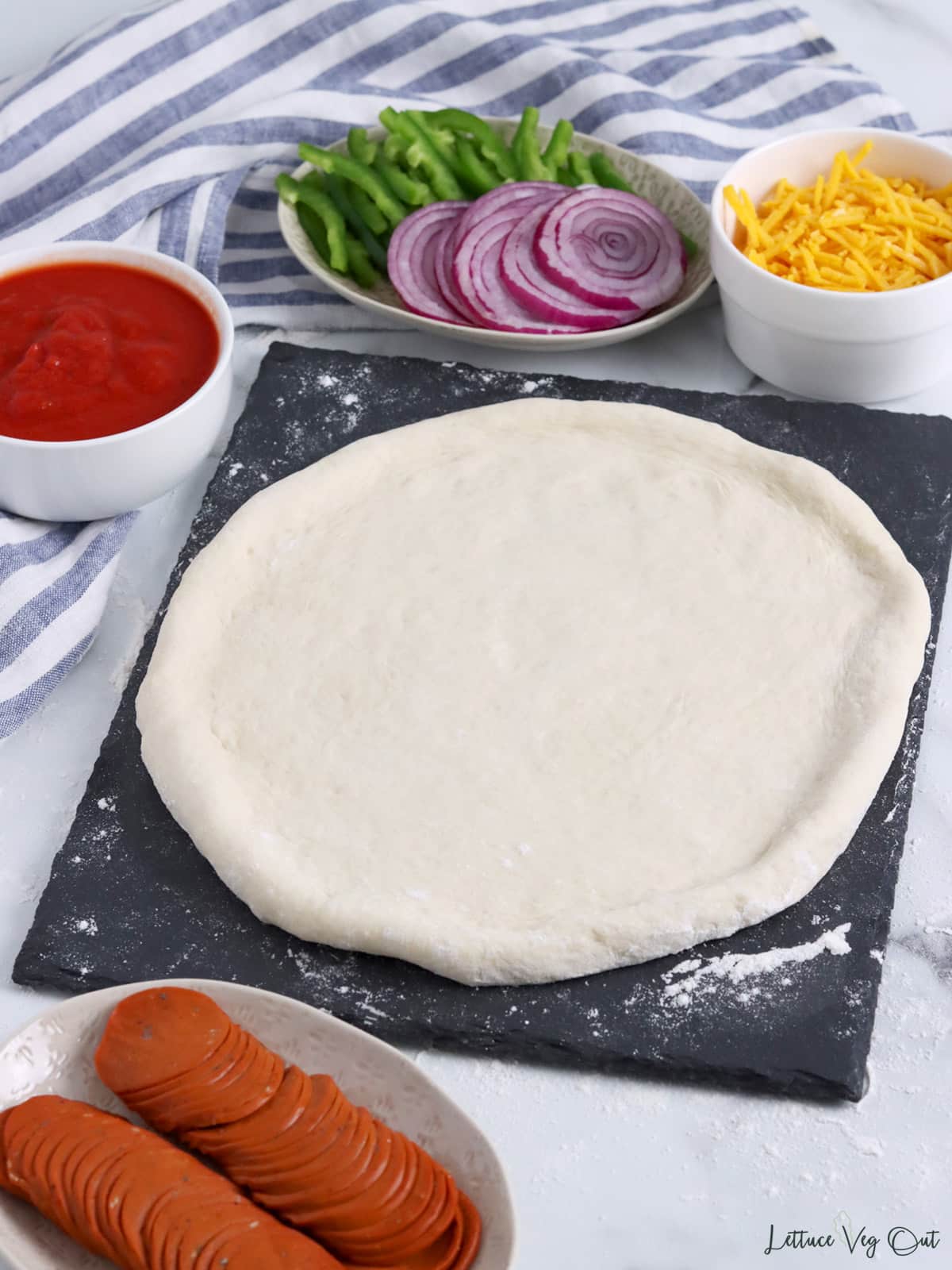
This post contains affiliate links (including Amazon Associates) and I earn from qualifying purchases.
Is Pizza Dough Vegan?
Pizza dough is typically vegan, but this isn’t the case for all recipes or restaurant options.
Classic pizza dough should use basic ingredients like flour, water, yeast, salt and maybe olive oil. This makes most pizza dough options egg free and dairy free.
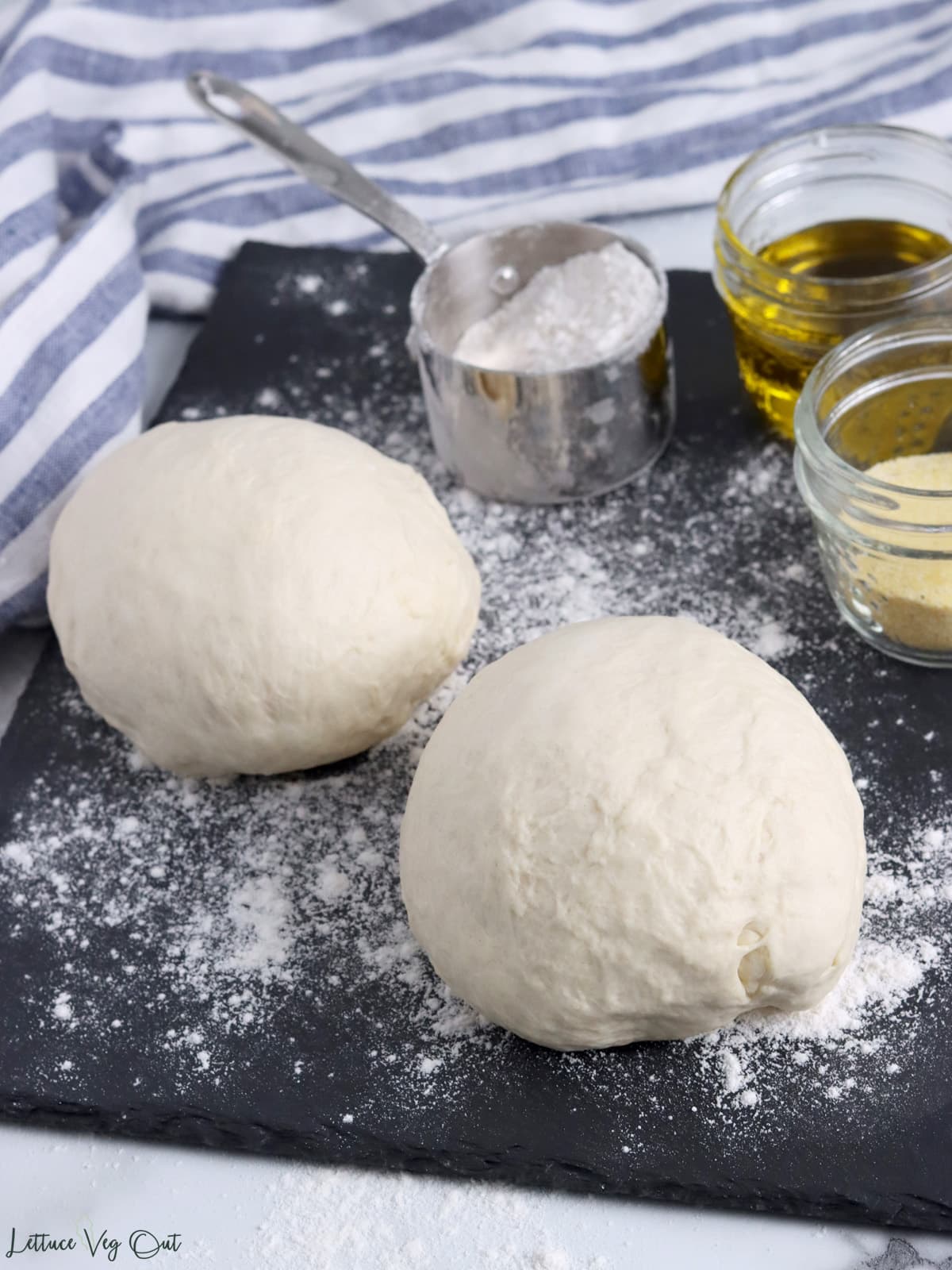
If eating out, it’s always best to ask if the pizza crust is vegan. Restaurants may use milk ingredients and even honey when making their dough, however eggs are unlikely.
If you’re concerned about cross contamination with non-vegan foods, ask the restaurant how their pizza is prepared and if it might touch anything you don’t want.
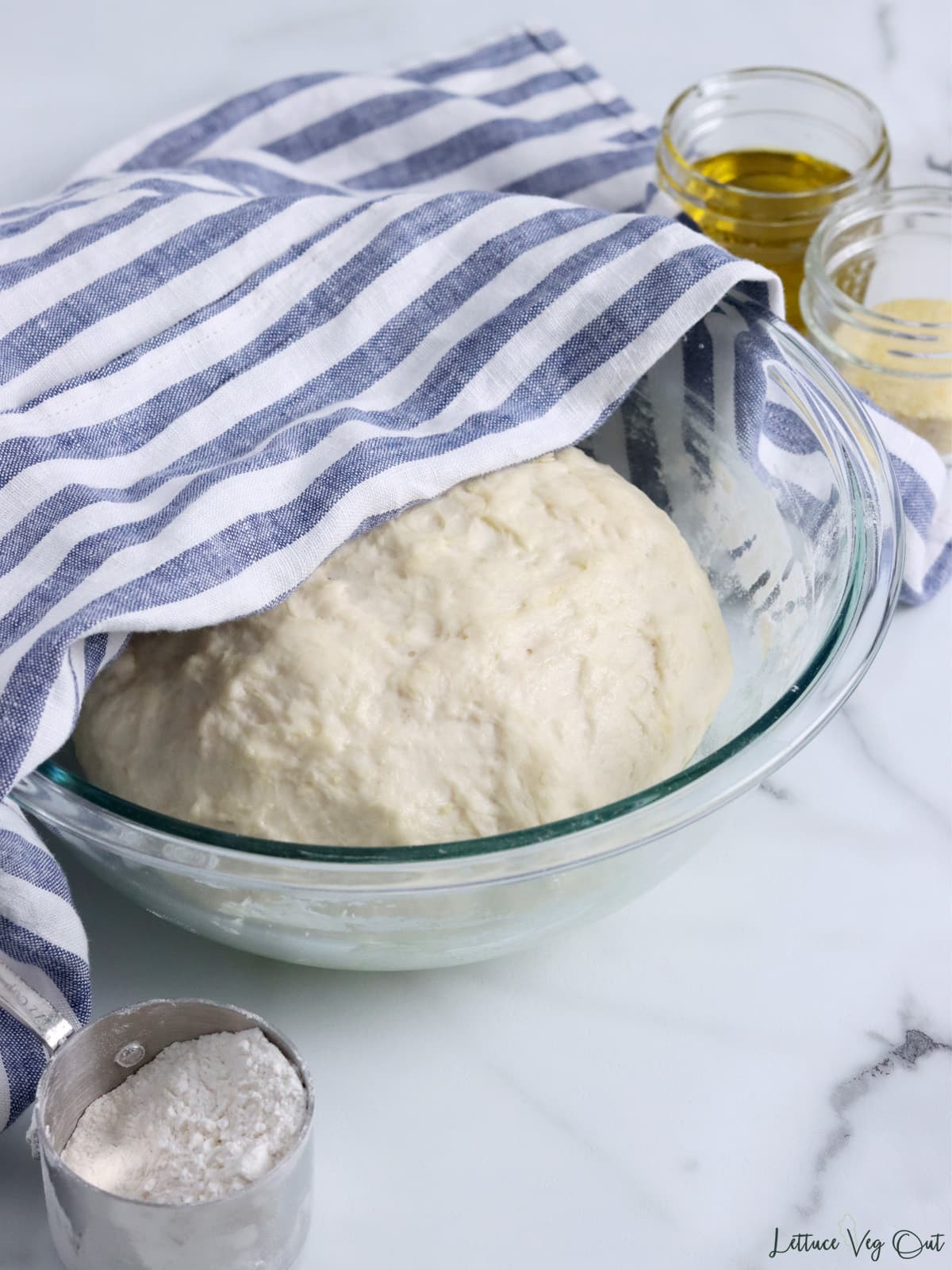
Homemade Pizza Dough Ingredients
The ingredients needed to make homemade pizza dough are quite basic. There aren’t many substitutions that can be made in this recipe, but a few options exist.
- Water: Start making dough with lukewarm water that feels warm to the touch but doesn’t steam.
- Sugar: Sugar is critical when activating yeast. Alternatives like maple syrup or organic cane sugar can work but the substitute must contain actual sugar. Sweeteners like stevia or sugar alcohols (ex. erythritol) will not work.
- Active dry yeast: There are a few types of yeast; this recipe uses active dry yeast. Quick yeasts are an option and don’t need to activate the same way dry yeast does, but they still require some sugar to work properly.
- Salt: Balance and enhance the dough’s flavors with some salt.
- Olive oil: Oil helps keep the dough soft and pliable while adding rich flavor.
- All-purpose four: All-purpose flour creates a deliciously soft and fluffy crust that crisps beautifully. You can use up to 1 cup of whole wheat flour if you like. I haven’t tested this recipe with gluten free flour alternatives, but this dough relies on gluten to form properly.

How to Make Pizza Crust
Pizza dough is one of the easiest homemade doughs to make. If you’ve made any yeast-based bread before, this should be a simple recipe.
If you are new to making homemade or yeast-based dough, I highly recommend reading the detailed directions and looking at the pictures below. It’s not a hard process but there are a few things to learn before you begin!
Step 1: Activate Yeast
First, you'll need to activate the dry yeast. To do this, get some lukewarm water and sugar.
Lukewarm water is about 100 °F. It should feel warm to the touch but not release any steam.
Then add sugar to your lukewarm water to activate the yeast. Organic or cane sugar options are fine to substitute; you can also use maple syrup. Sugar substitutes that don’t contain actual sugar will not work.
Once sugar is in the water, give it a quick stir to help the sugar dissolve. It does not need to be fully dissolved.
Sprinkle yeast over top of the water and let this mixture sit. There’s no need to stir it.
The yeast should foam and coat the sugar water’s entire surface. This takes 5-10 minutes, depending on how warm and humid your room is.
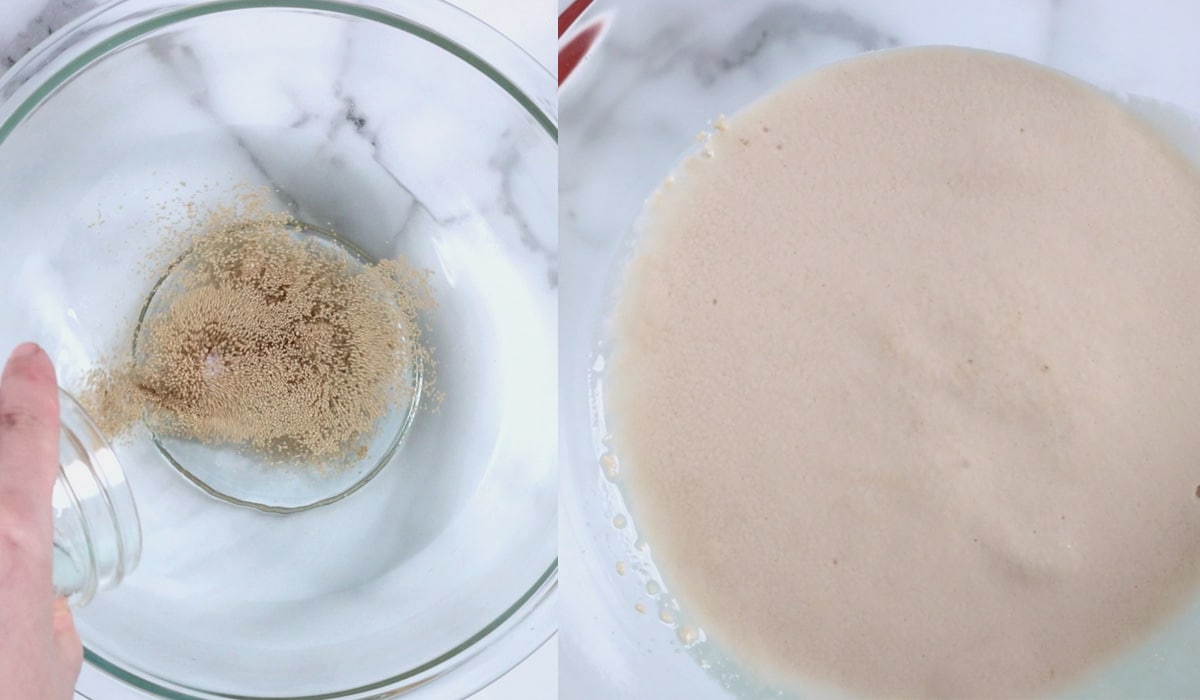
If the yeast doesn’t foam after 10 minutes, it’s likely dead. Either your water was too hot, the yeast was too old, or you didn’t add sugar first.
Try again and if the yeast doesn’t foam a second time, you likely need fresh yeast.
Step 2: Make Dough and Let Rest
Once the yeast is foamy, add salt and olive oil to your mixing bowl. Then start adding flour; I start with about 2 cups.
Use a spoon to stir the dough until a ball starts to form. When it becomes hard to stir, dump the dough onto your countertop and use your hands to knead the dough.
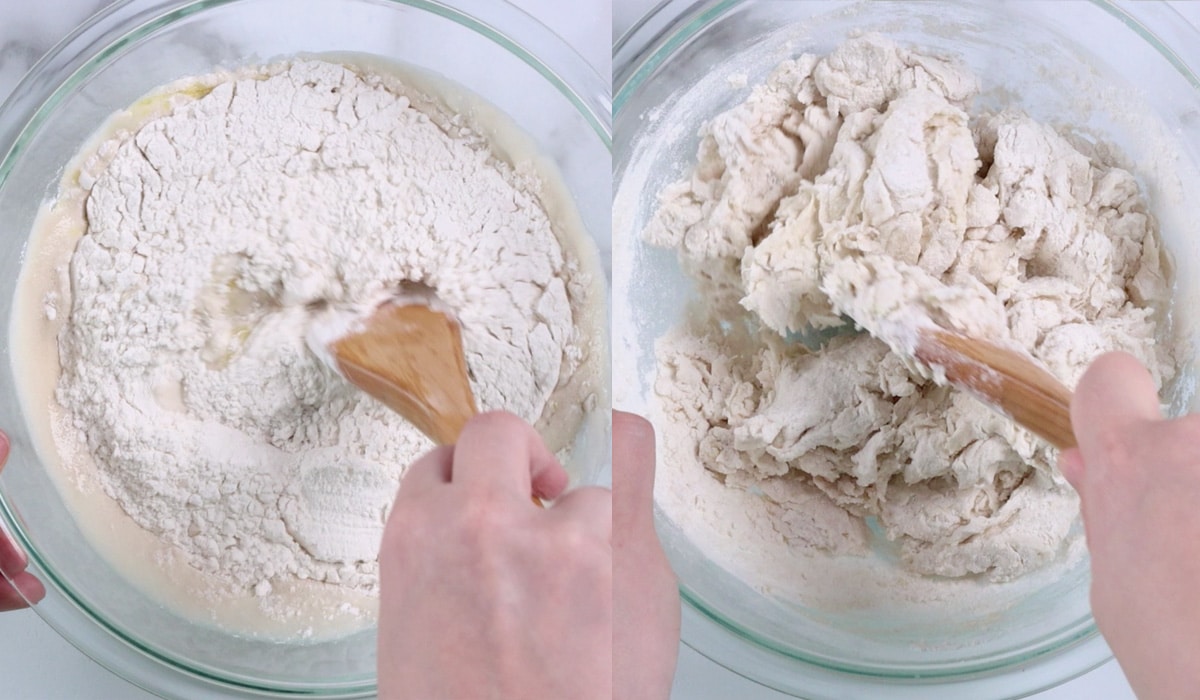
Knead until the dough feels smooth. Add 1-2 tablespoons of extra flour at a time; you’ll likely need ¼-½ cup.
The finished dough should be tacky but not sticky. This means if you touch the dough, it should very lightly stick to your hand, but when you pull away, a chunk of dough doesn’t come off. If a piece of dough sticks to your hand, you likely need to add more flour.
When the kneaded dough feels tacky (but not sticky) roughly shape it into a ball.
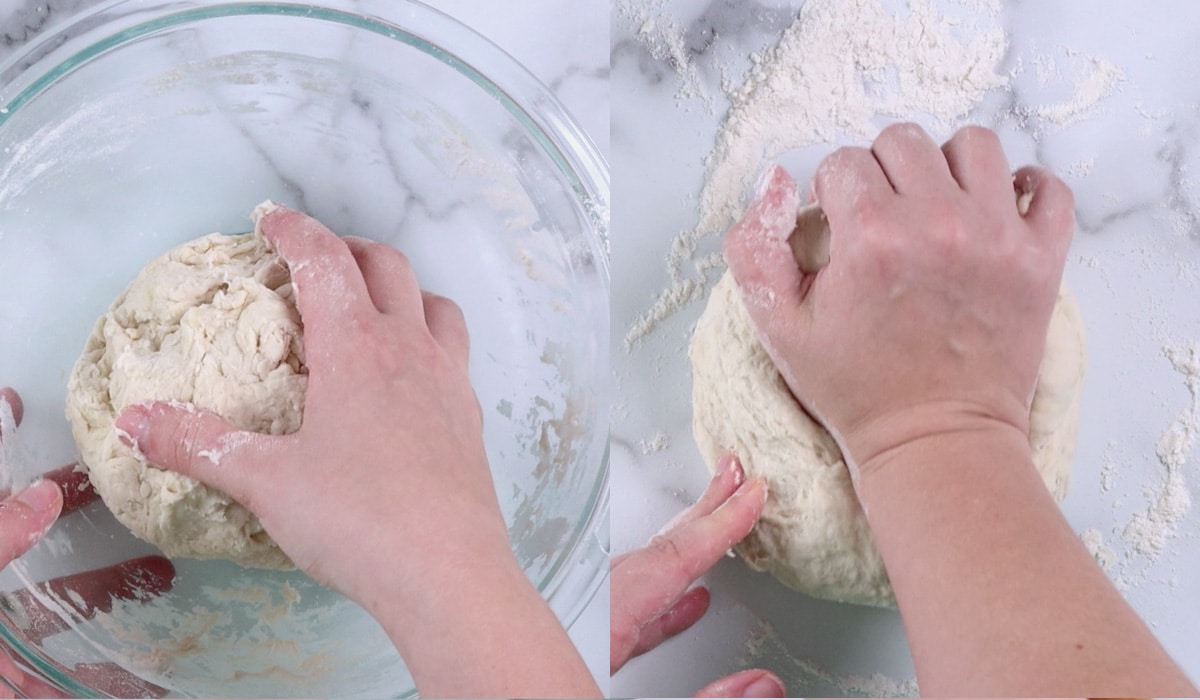
Add the dough ball back to your mixing bowl and lightly coat the dough with some extra olive oil (about ½-1 teaspoon). Oil helps prevent the dough from drying while it rests.
Let the dough rest for 10-30 minutes. This is a great time to prepare pizza toppings.
Your dough doesn’t need to double in size, but it needs to rest for at least 10 minutes.
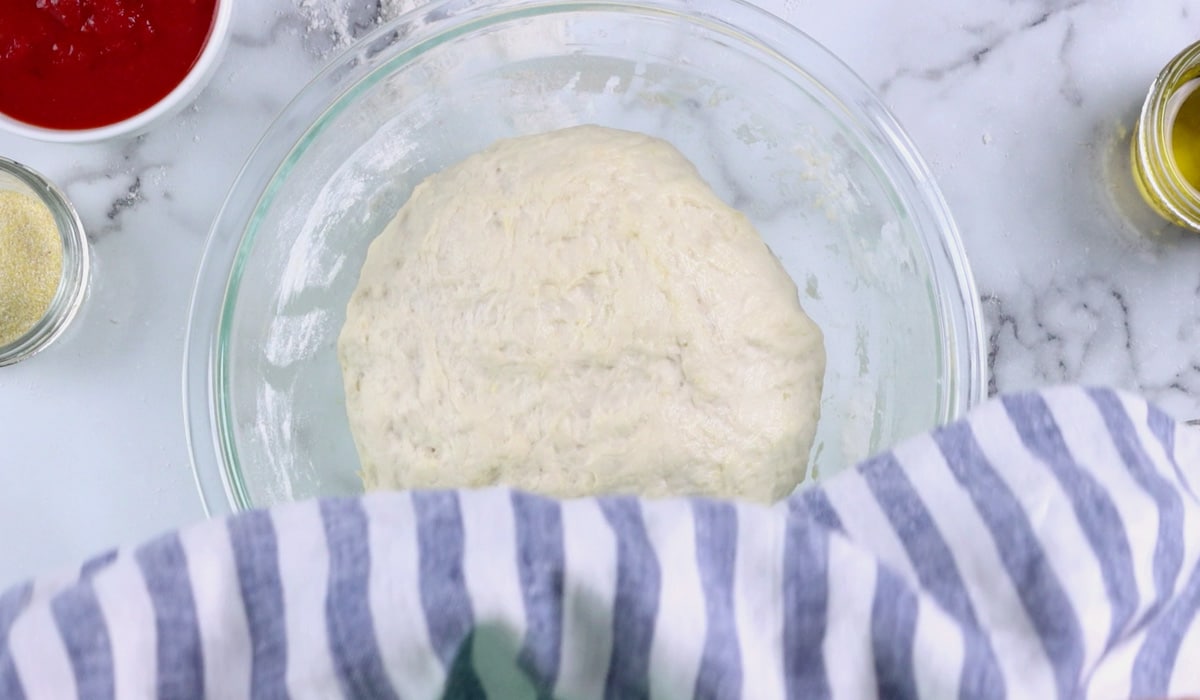
Step 3: Roll Dough
When the dough is rested, cut it into 2-3 pieces (for 2 larger or 3 medium-sized pizzas).
Gently shape the piece of dough into a ball, then place onto a generously floured countertop. Sprinkle some extra flour onto the dough.
Roll dough by gently pressing it flat with a rolling pin, moving in all directions to maintain a circular shape. As you roll, lift the dough and make sure it doesn’t stick to the counter. Add extra flour to your rolling surface or the dough surface if sticking occurs.
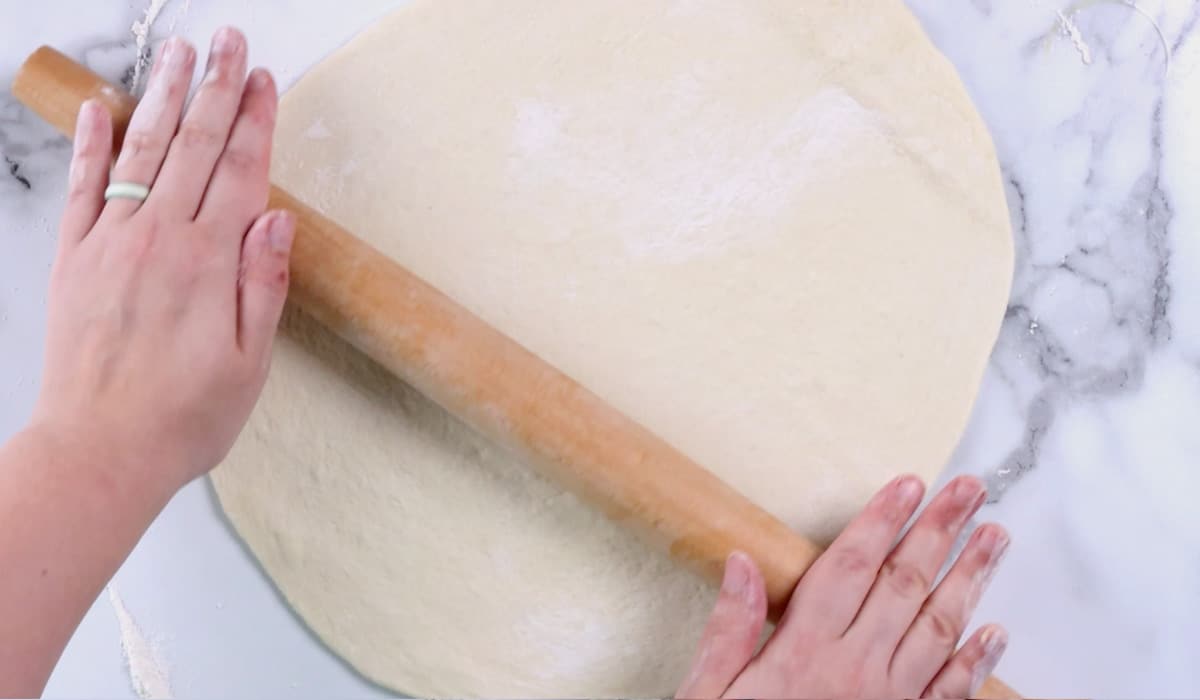
Roll this dough as thin or thick as you like (¼ inch thick is ideal). The crust will nearly double in thickness as it bakes, so keep this in mind when rolling out dough.
I typically like to roll my dough as thinly as possible. It’s a very elastic dough and will shrink back in size as you roll. Be patient and press the rolling pin more firmly as the dough rolls out further.
Step 4: Assemble Pizza and Bake
Lightly coat a baking tray with cornmeal. Cornmeal helps prevent dough from sticking to the baking tray and will add a great crunch to the bottom of your crust. Do not use parchment paper or a silicone baking mat for this recipe.
Carefully transfer the rolled pizza crust onto your baking tray. I typically fold the rolled dough in half, then into quarters, for easy pick up and transfer. Unfold it onto the tray, then you’re ready to make dough into pizza!
Create a crust edge by pinching edges of the dough. I simply fold some dough under itself along the outside to create a crust.
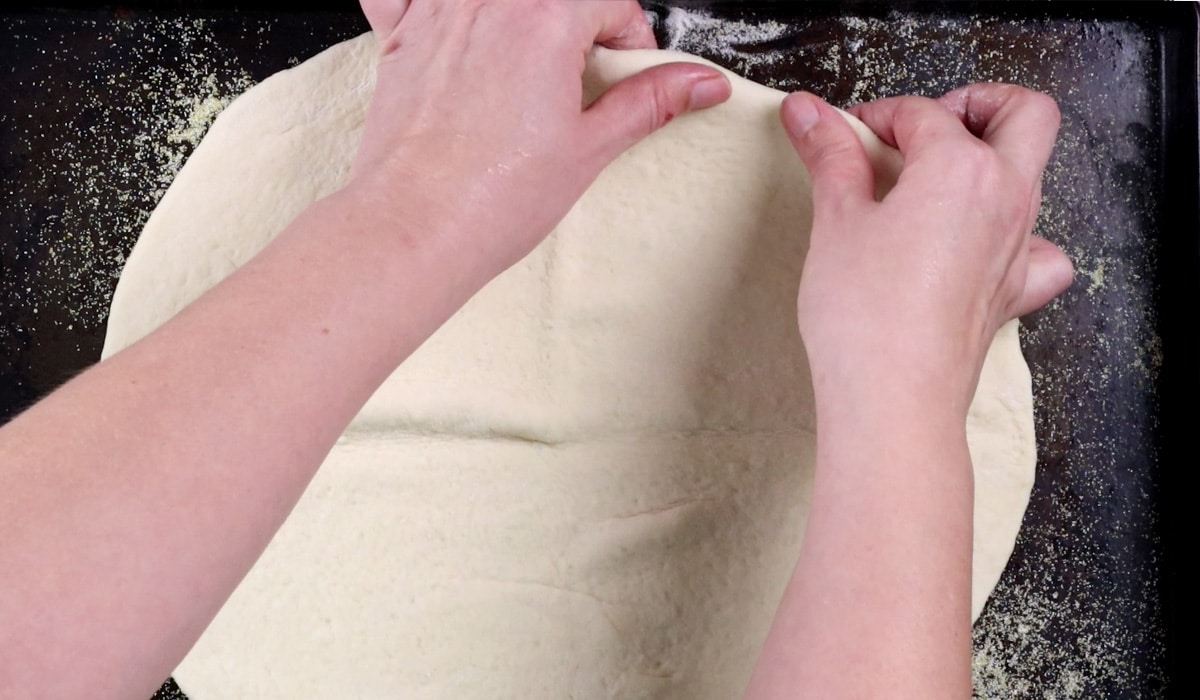
Then top the pizza however you like! For a classic pizza, start with tomato sauce then add vegan cheese shreds (these are much more likely to melt if placed directly onto your sauce).

Follow this with any other toppings you want!
Before baking, brush the crust edge with some olive oil. This makes for a truly spectacular crust that becomes golden brown in the oven.
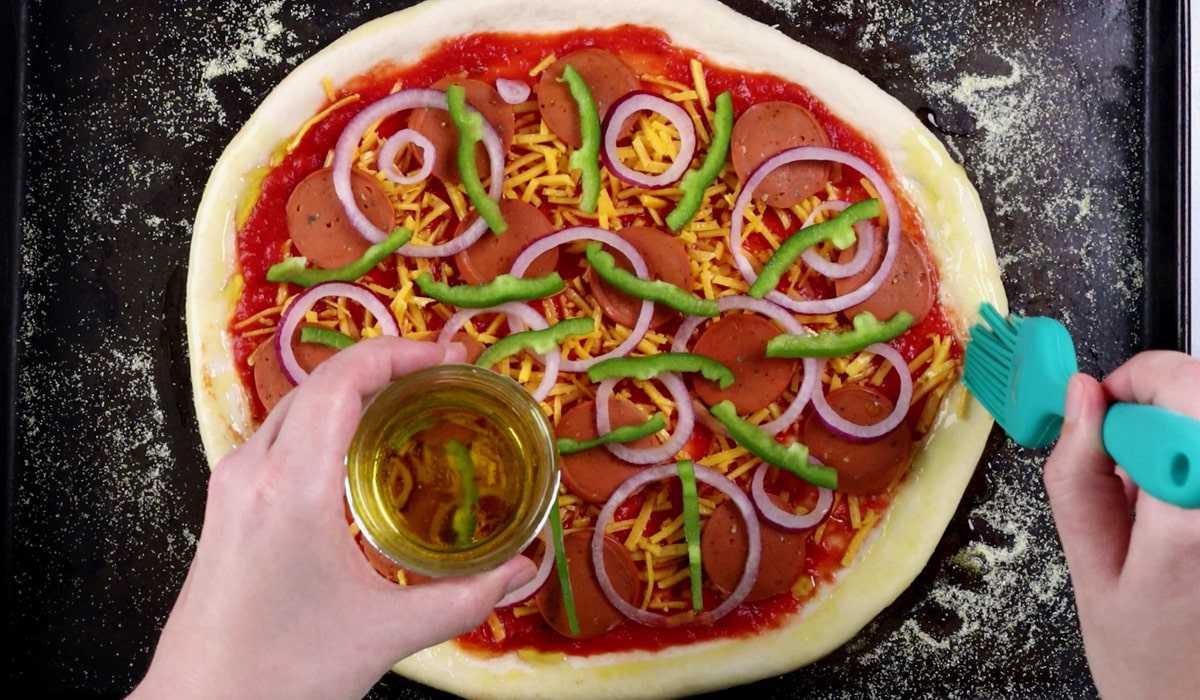
Place your assembled pizza into an oven that’s preheated at 425 °F. It’s critical that the oven is fully preheated before placing pizza in, and that you use the center rack.
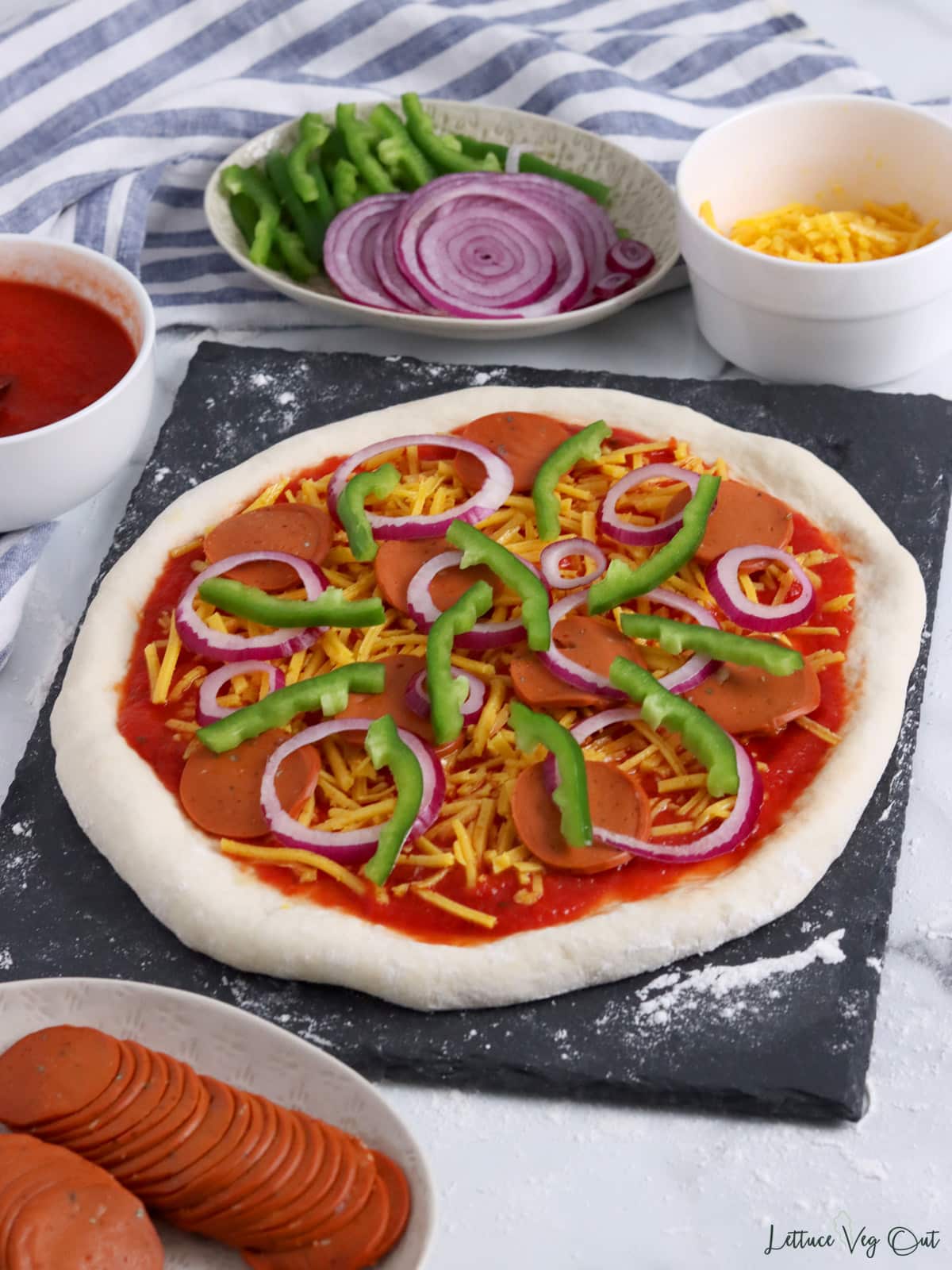
Bake for 10-13 minutes, until the crust edge is nicely golden brown. Thicker crusts, and pizzas with more toppings, take long (may take up to 15 minutes).
Only cook one pizza at a time. While the first cooks, assemble your second on a separate baking tray.
Once cooked, carefully transfer to a cutting board, then slice and serve. If you don’t have a pizza wheel cutter, a regular large knife works fine.
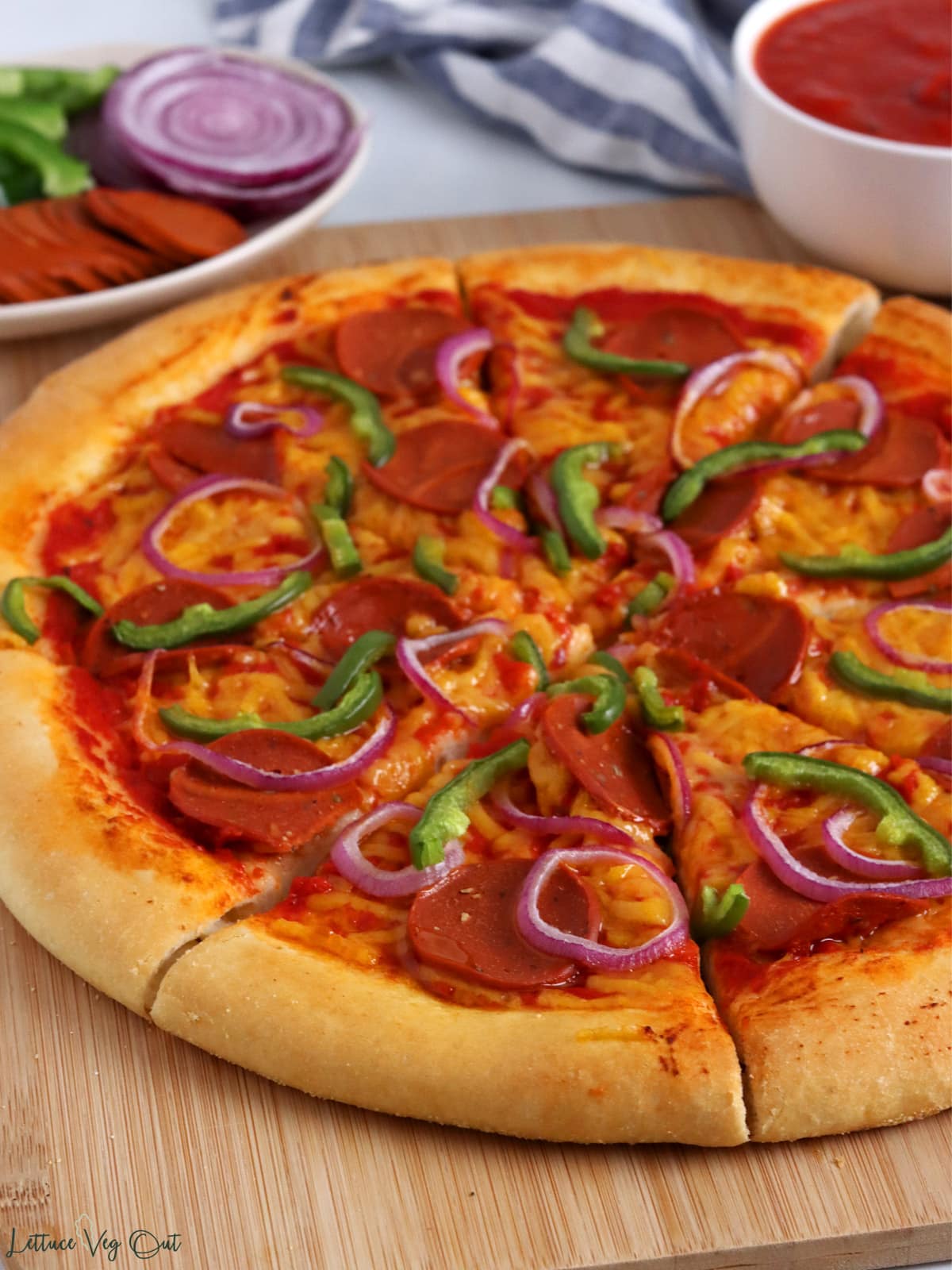
The Ultimate List of Vegan Pizza Toppings
There are truly endless ways to prepare vegan pizza at home. The possible toppings you can enjoy are only limited by your imagination!
Get creative with the sauce, vegan cheese, vegan meats and other proteins, veggies and even fruits!
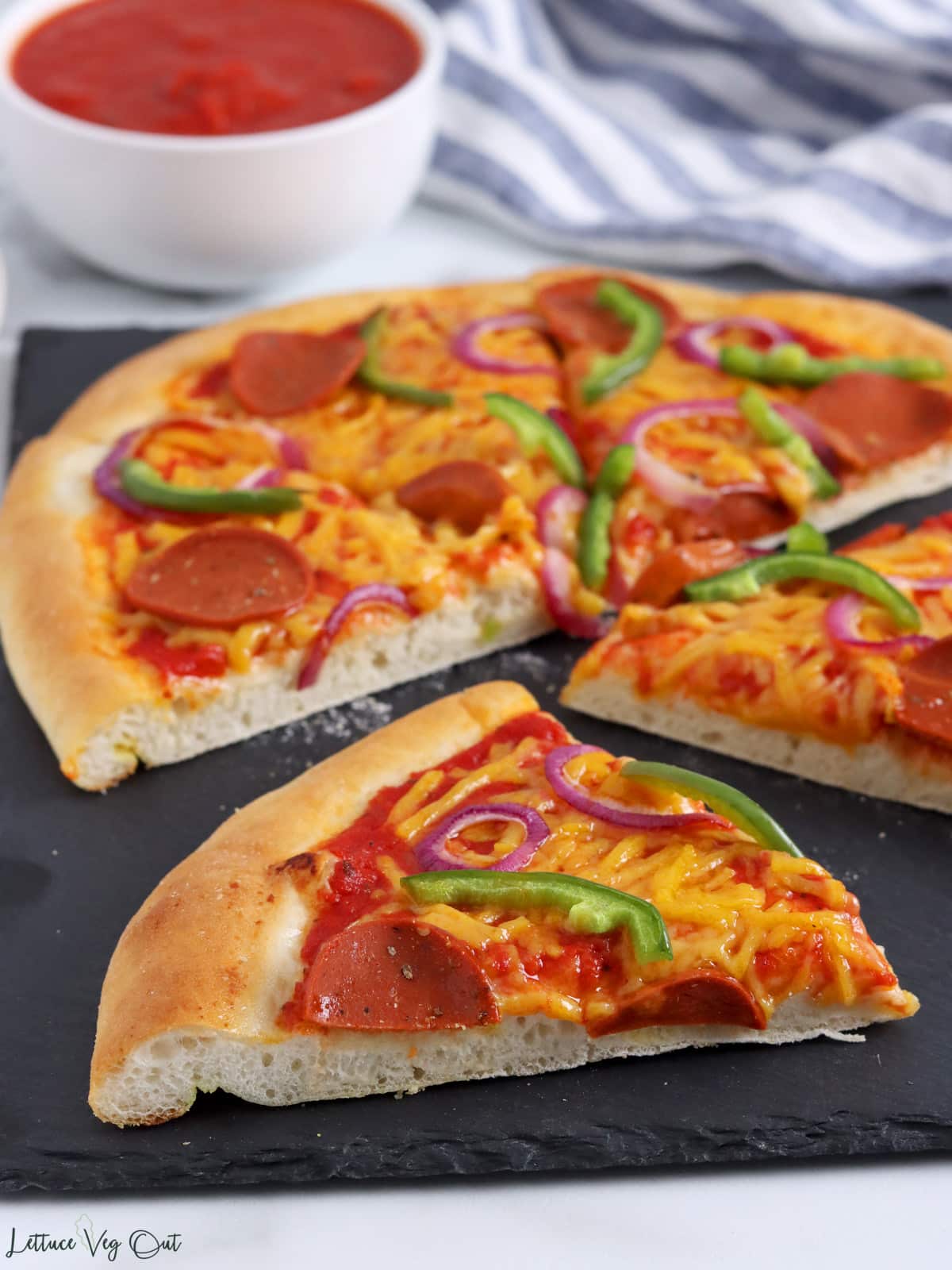
Some delicious vegan pizza sauce options are:
- Classic tomato sauce/marinara
- Vegan cheese sauce
- White sauce/ bechamel
- Pesto
- BBQ sauce
- Buffalo sauce
- Caesar dressing
Try out different vegan cheese options too:
- Store bought vegan cheese shreds (mozzarella or cheddar)
- Vegan parmesan
- Vegan ricotta
- Vegan feta
- Vegan goat cheese
And don’t forget about vegan meat or other protein choices:
- Pepperoni
- Ham
- Bacon or bacon bits
- Sausage or sausage crumbles
- BBQ chickpeas
- BBQ jackfruit
- Ground “beef”
As for veggies and fruits, the options are endless:
- Red onion
- Caramelized onions
- Artichoke hearts
- Tomato slices
- Bell pepper
- Roasted red peppers
- Mushrooms
- Olives
- Broccoli
- Pineapple
- Figs
- Zucchini
- Roasted garlic
- Corn
- Banana peppers
- Jalapeno peppers
- Grilled eggplant
- Spinach
- Asparagus
- Roasted sweet potato or squash
- Sun dried tomatoes
- Avocado
You can also finish off the pizza with tasty toppings once out of the oven:
- Balsamic glaze
- Fresh herbs like basil or oregano
- Fresh greens like arugula/ rocket
- Crushed red chili flakes
- Vegan parmesan cheese
- Olive oil drizzle
- Hot sauce
Get creative and mix toppings to create your ultimate vegan pizza. The best part about homemade pizza is you can load up on as many toppings as you like!
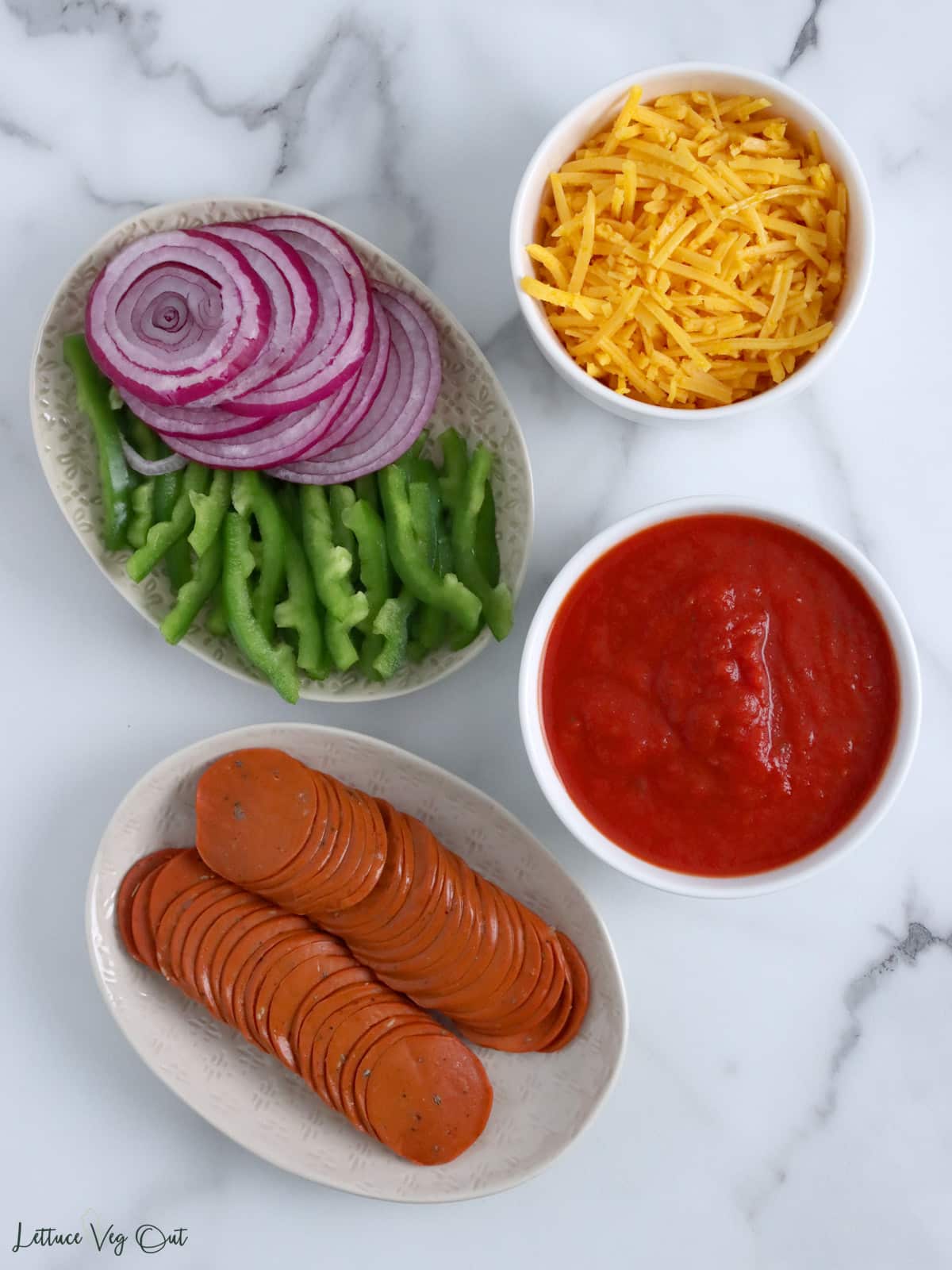
How to Refrigerate and Reheat Leftover Pizza
Pizza is best eaten fresh from the oven. If you have leftovers, let it cool to room temperature, ideally on a wire cooling rack so the crust doesn’t become soggy.
Once cooled, transfer to an airtight container and refrigerate for up to 5 days.
Pizza is best reheated in an oven (an air fryer could work but I haven’t tried it). Simply place your pizza slices onto a baking tray and warm it to 350 °F.
You can microwave leftover pizza, but the crust won’t be crisp. You can also eat cold leftover pizza if you like. I haven’t tested storing extra dough in the fridge or freezer.
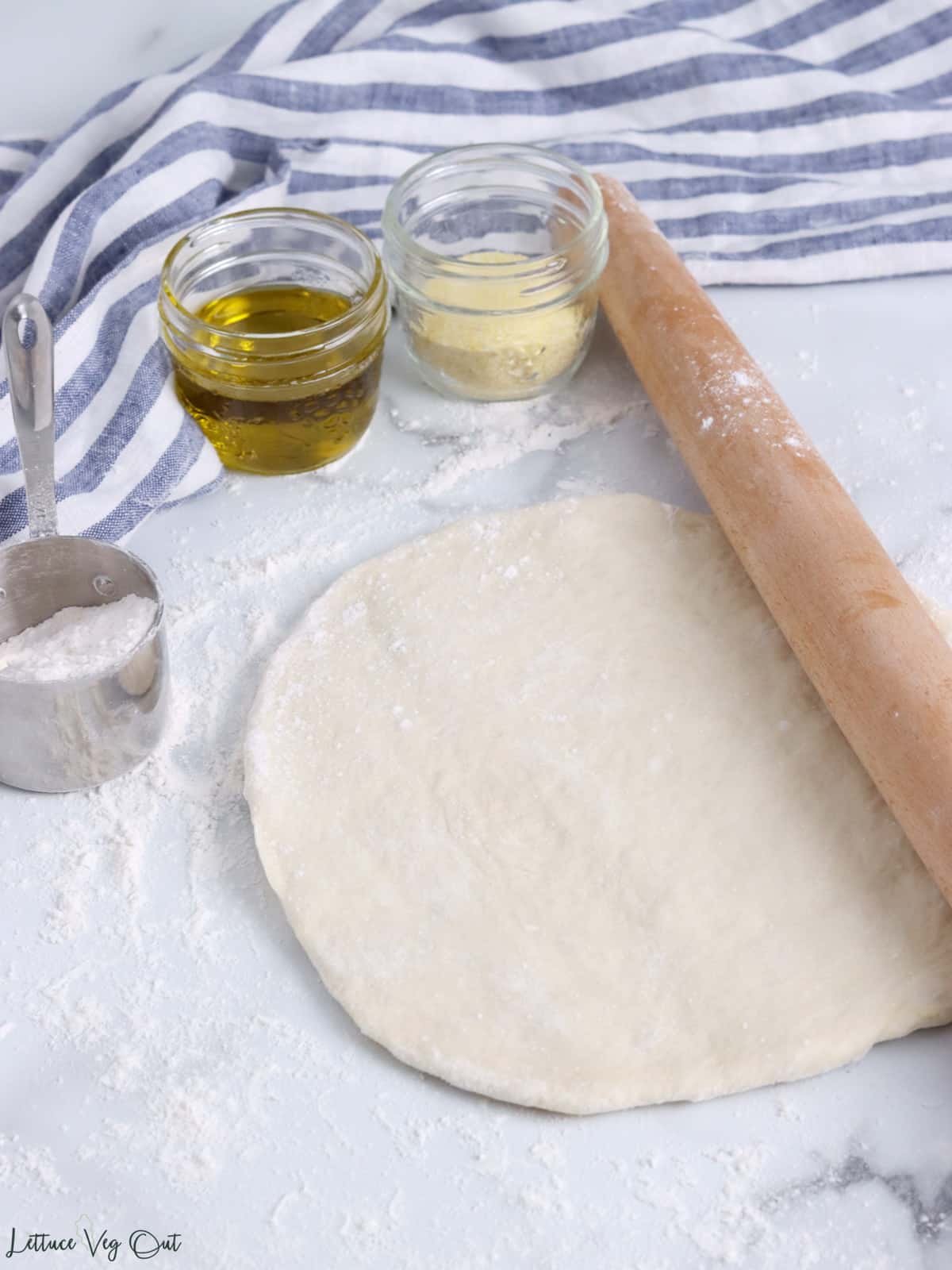
📖 Recipe

Vegan Pizza Dough
Equipment
- Measuring cups
- Measuring spoons
- Kitchen towel
- Large knife
Ingredients
- 1 cup lukewarm water
- 2 teaspoons sugar
- 1 tablespoon active dry yeast (14 g)
- ½ teaspoon salt
- 1 tablespoon olive oil
- 2 ½ cups all-purpose flour (370 g) + extra for rolling
- cornmeal (to coat pan)
- olive oil (to brush onto crust)
To Serve
- pizza sauce
- toppings
Instructions
Step 1: Activate Yeast
- Add lukewarm water, sugar and dry active yeast to a large mixing bowl. Lukewarm water is about 100 °F and should feel warm to the touch but not release steam.
- Allow the yeast to activate; it should become completely foamy over the surface of the water in 5-10 minutes.
Step 2: Make Dough and Let Rest
- When the yeast activates, add salt and olive oil.
- Start adding the flour, beginning with about 2 cups (295 g).
- Stir until a ball of dough starts forming and you can no longer stir. Then, switch to using your hands to knead the dough (you can dump the dough onto your counter for this).
- Add extra flour, 1-2 tablespoons at a time, until the dough feels smooth. It should feel slightly tacky but not stick to your hands.
- Shape your dough roughly into a ball and place it back into the mixing bowl. Coat the dough with a light layer of extra olive oil.
- Cover the bowl with a kitchen towel and let the dough rest/rise for at least 10-30 minutes; 15-20 minutes is ideal.
- Use this time to prep toppings.
Step 3: Roll Dough
- Preheat your oven to 425 °F.
- Once the dough has rested, cut it into 2-3 pieces (2 larger pizzas or 3 medium pizzas).
- Generously coat your countertop with flour, then place a piece of the dough onto it. Dust extra flour over the top of the dough.
- Roll the dough into a circle as thinly as you like; the dough will nearly double in thickness once baked, so keep this in mind when deciding on the thickness of your pizza crust.
Step 4: Assemble Pizza and Bake
- Coat a baking tray with a light sprinkle of cornmeal, then carefully transfer the pizza dough onto it.
- Pinch around the edges to form a crust (I fold a small amount of dough underneath itself to form a raised edge).
- Now you can top your pizza however you like; I used tomato sauce, vegan cheese, vegan pepperoni, sliced red onion and green peppers for this recipe.
- Brush a small amount of olive oil over the crust edge of the pizza.
- Place the assembled pizza into your preheated oven and cook for 10-13 minutes, until the crust turns golden brown.
- When out of the oven, carefully transfer to a cutting board, slice and serve.
- Only bake one pizza at a time. While the first pizza cooks, assemble the second one.
Notes
Nutrition
More Vegan Bread Recipes
Like this recipe? You should also try:

About Nicole Stevens
Nicole is a long-time vegan with a Masters of Science in Food and Nutrition.
She helps people thrive on a vegan diet with balanced recipes.

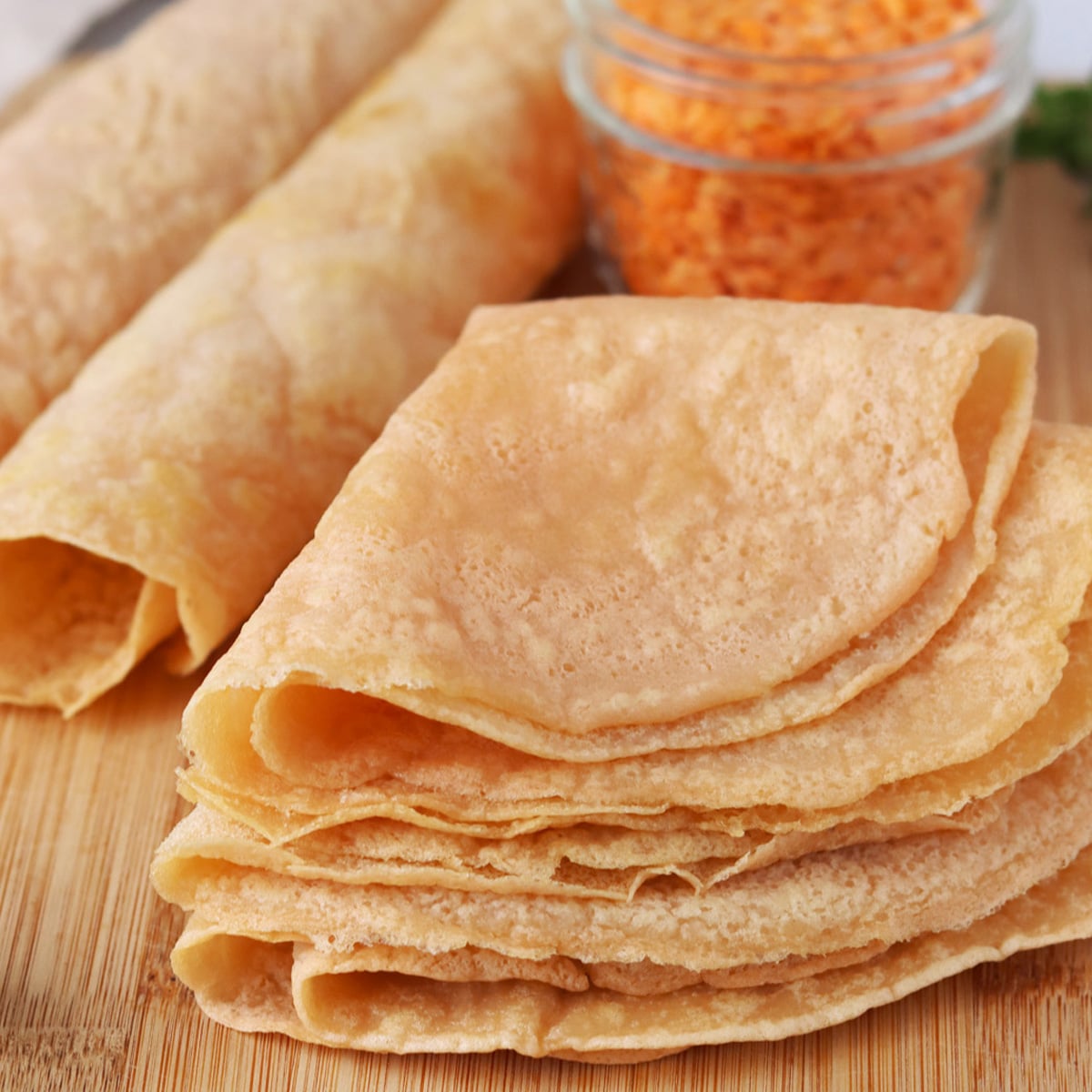
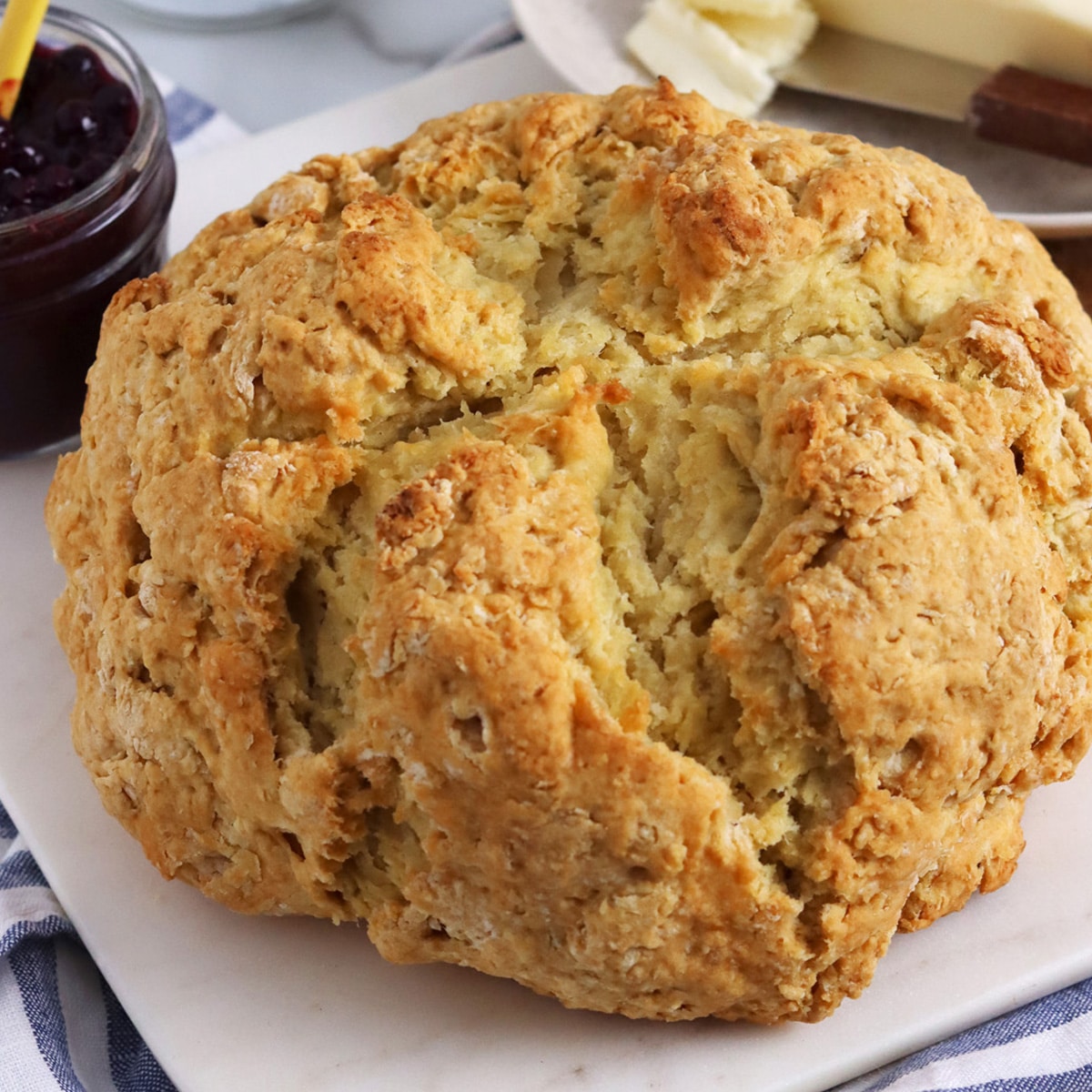


Reply to comment